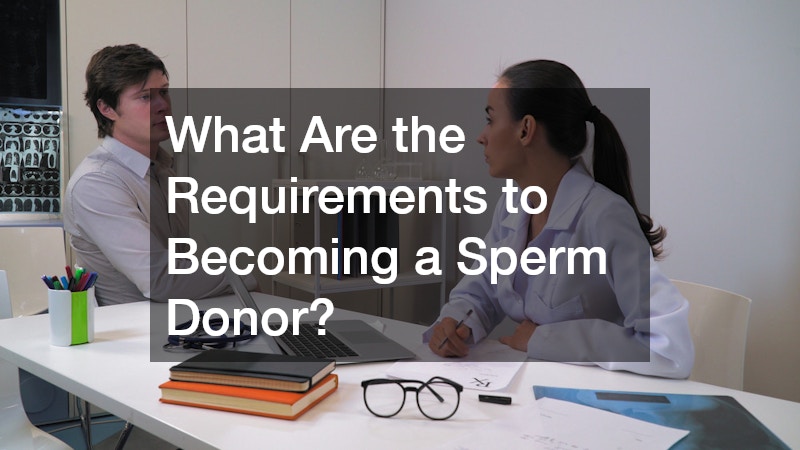Sperm donation has become an invaluable resource for many, providing a viable solution for individuals and couples facing infertility challenges. Not only is it a way to help those in need, but it can also be a rewarding experience for the donor, offering a chance to assist in the creation of new family dynamics. Understanding the intricacies of sperm donation is crucial for anyone considering taking this path.
The process of becoming a sperm donor involves more than just the act of donation. There are specific requirements, rigorous screenings, and commitments that a potential donor must adhere to.
These steps ensure that the donation is safe, ethical, and beneficial for both the donor and the recipient.
In this article, we explore the comprehensive requirements necessary to become a sperm donor. This includes understanding the health and lifestyle criteria, the legal implications, and what the process entails. We’ll examine the necessary steps and why they are important for a successful donation experience.
Basic Eligibility Criteria
The first step in becoming a sperm donor involves meeting the basic eligibility criteria set by donation centers. Typically, donors must be between the ages of 18 and 39, although some centers have stricter age limitations. This age range is chosen because it usually represents optimal reproductive health, ensuring viable and healthy sperm.
Potential donors also need to pass an initial health and lifestyle questionnaire. This assessment covers areas such as family medical history, sexual health, and lifestyle habits. Many donation centers require the donor to be a non-smoker and maintain a healthy weight to ensure the best possible sperm quality.
Moreover, some centers may require specific educational qualifications or ask for proof of academic achievements. This requirement can vary significantly across different institutions. However, it is often driven by recipient preferences for the donor’s traits and achievements, rather than biological necessity.
Medical Screening Process
After meeting the basic eligibility criteria, the next step is to undergo a thorough medical screening process. This includes a physical examination to assess the donor’s overall health and reproductive system. Testing for infectious diseases like HIV, hepatitis B and C, and STIs is crucial to ensure safe donations.
Additionally, genetic testing is performed to check for inherited conditions that could affect future children. This comprehensive analysis helps prevent passing on genetic disorders and ensures that the sperm is safe for use in assisted reproductive technologies. A significant focus is placed on examining the donor’s family history to detect any hereditary health issues.
Semen analysis is another critical part of the screening process. It assesses the sperm count, motility, and morphology to ensure they meet the high standards required for donation. Only those with healthy, active sperm that meet the necessary criteria will move forward in the sperm donation process.
Commitment and Legal Obligations
Sperm donors must also be willing to commit to the donation process, which can often span several months. This commitment involves regular visits to the sperm bank for donations, maintaining a healthy lifestyle, and adhering to any abstinence guidelines before donations. Donors must also understand the time commitment involved, as regular donations may be required.
Legal obligations are another integral part of becoming a sperm donor. Donors must sign a contract that clearly outlines their rights and responsibilities, ensuring that they are aware of the implications of their donation. This agreement typically absolves the donor of any parental rights or financial responsibility toward future offspring.
The legal framework of sperm donation varies by region, so understanding local laws is essential. In some areas, anonymity is guaranteed to the donor, while in others, offspring may have the right to contact them once they reach a certain age. Therefore, it is crucial for donors to be fully aware of both their rights and any potential future contact before beginning the process.
The Psychological Impact of Donation
Beyond the medical and legal aspects, potential sperm donors should consider the psychological implications of their decision. While many donors find the experience fulfilling, it’s important to be prepared for the emotional consequences that may arise. Understanding that you might have biological children in the world can be a complex realization.
Counseling services are often available to help donors navigate these feelings. Many donation centers offer psychological evaluations to assess the donor’s readiness and ability to handle the emotional aspects of sperm donation. These services ensure that donors are fully informed and comfortable with their decision before proceeding.
Moreover, some donors develop a sense of pride and satisfaction from contributing positively to others’ lives. However, it is just as common for donors to have mixed feelings, especially regarding the anonymity and potential future contact with biological offspring. Being well-prepared with these considerations is crucial for anyone considering becoming a sperm donor.
Becoming a sperm donor is a generous and impactful decision that requires careful consideration and a strong commitment to the process. From meeting rigorous eligibility criteria and undergoing comprehensive medical screenings to understanding the legal and psychological impacts, each step is crucial to ensure successful, safe, and ethical donations.
The requirements for sperm donation are designed to protect all parties involved, including the donor, the recipients, and any potential offspring. As more people turn to sperm donation as a means to build their families, the importance of maintaining high standards and ethical practices grows ever more critical.


